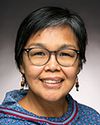Thank you. I'm Catherine Cook. I am a medical doctor, and I am Métis from Manitoba.
I'd like to thank you for including us in this important study.
In 2020, I began serving as the University of Manitoba's first vice-president, indigenous. My goal has been to address the gaps and barriers to equitable access for indigenous success and achievement in education and in health care for indigenous people through systems change.
Today 8.8% of the 30,000 students at U of M self-declare as indigenous. It is the largest indigenous student population in Canada, but the indigenous population of Manitoba is 18%, so it isn't reflective. We must address this gap and work together to ensure that indigenous students pursuing post-secondary education and training receive the same quality of K-12 education and have the same sense of belonging.
The challenges that existed when I was a student still exist today. Remote geography, limited capital investment for education and training sites, and program funding for education services remain major barriers. The ambiguity of financial responsibility, the scope of educational practice and the potential for areas requiring government collaboration and community partnership have never been clear. As a result, even when communities or tribal councils establish productive partnerships for program delivery, the capital investment and infrastructure on federal reserve lands is almost non-existent for training and insufficient for the programming needs.
When I began my tenure, my team committed to engage indigenous community partners in strategy development, and then COVID hit, revealing further inequities. Indigenous students living in rural and remote areas identified challenges to engaging in online learning such as poor Internet connectivity and technology, the lack of appropriate study spaces in busy households and the shortage of academic resources in their communities. Many of these challenges were shared by urban-based indigenous students.
As the pandemic continued, we hosted engagement sessions where participants identified other barriers to post-secondary education such as experiencing culture shock, homesickness and racism, the high cost of education, relocation and living expenses and the fear of losing their connection to culture. This is not new information.
We must work collaboratively to build a fluid and comprehensive continuum of education. Education is the most significant social determinant of good health and wellness for individuals and for communities. Without it, we cannot access employment that will support and sustain our families. We won't have choices for good housing, food security, healthy living or control over our lives. Everyone must feel that we have something to contribute to our families and to society in general. Living in poverty because of a lack of education is the ultimate life sentence of unhappiness and despair.
We need to look at the organizational structure of indigenous education and find new delivery models. U of M recently entered a partnership with the Mastercard Foundation's EleV program, which provides the financial opportunity to explore new opportunities that were codesigned by first nations, Métis and Inuit partners. Our main focus is to return education to the community as much as possible.
One example is a new learning hub in Pinaymootang First Nation. This hub provides a space with excellent Internet, technology and wraparound supports. It allows students attending any Manitoba post-secondary institution to access online classes and programs with the goal of developing the in-person, in-community delivery of training that's identified as a priority by the community. It's the first of a series of hubs that will be established throughout Manitoba.
The learning hubs address some of the previously mentioned systemic challenges, and they also keep young people near language speakers, culture and support systems. They provide opportunities for inspiring and mentoring students still in K-12, and they increase the chances of graduates staying in the community to work, which will contribute to building capacity and community.
We're grateful to offer our experiences working in this area. The federal government has a responsibility to invest in developing a continuum of education and to support capital investment for training and education opportunities. The continuum requires a commitment for a fulsome partnership with school divisions; tribal councils; post-secondary institutions; provincial, federal and indigenous governments; and partners in industry and philanthropy.
Together, we can develop a comprehensive approach to a continuum of education that will enhance access and support through K to 12 and will bridge entry to and through post-secondary to career development.
Thank you.



